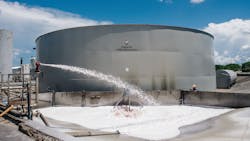Case study: Industrial fertilizer manufacturer replaces boilers with tankless water heaters
Wedgworth’s Inc., an industrial fertilizer manufacturer in Clewiston and Lake Placid, Florida, used a gas-fired boiler system to meet the hot water needs of its production processes in both facilities. In recent years, management found three problems with its boiler system:
- Boilers had poor service availability, with only one or two professional contractors in the area capable of handling maintenance issues in a timely and effective manner.
- The boilers created safety concerns. “When there is a safety mishap with a boiler, it is usually a major issue,” said Ken Bruce, director of liquid operations in Lake Placid.
- Boilers were insufficiently environmentally friendly. Diesel fuel does not burn cleanly enough, according to Bruce, who said the boilers burned fuel when there was no hot water demand.
The facilities required approximately 35,000 gallons of hot water daily. The average volume rate is 700 gpm, spiking up to 12,000 pounds of hot water in a matter of minutes. The objectives were to meet this high demand on a consistent basis, even when servicing was required; maximize fuel savings and maintain environmental stewardship.
Wedgworth’s installed 15 Noritz NC380 tankless units in Clewiston in 2017. Fifteen months later, the company combined seven of those units with 10 Noritz NCC300 tankless water heaters to create a 17-unit system at the Lake Placid facility to achieve energy efficiency and fuel savings while benefiting from the maintenance advantages that unit redundancy delivers. If one the 17 tankless heaters needed servicing, the other 16 would continue to deliver the required volumes of hot water to maintain operations.
Because of the large volume of water the Lake Placid processes demanded, management coupled the multiunit tankless water heater system with a stainless steel storage tank to maintain an always-ready supply of 185°F water to feed the blending equipment. The water heaters themselves are fed by a cold water tank whose contents are treated with water softeners to minimize hard water problems.
The tankless water heating systems at Clewiston and Lake Placid met the hot water needs of both facilities in an energy-efficient, environmentally responsible manner with minimal maintenance. Bruce anticipated maintenance costs down the road. “But I could easily replace 10, maybe more, of those tankless units annually, and still finish below my former expenses for boiler service. Add the required monthly and yearly boiler inspection fees, and the savings with tankless are tremendous," he said.
